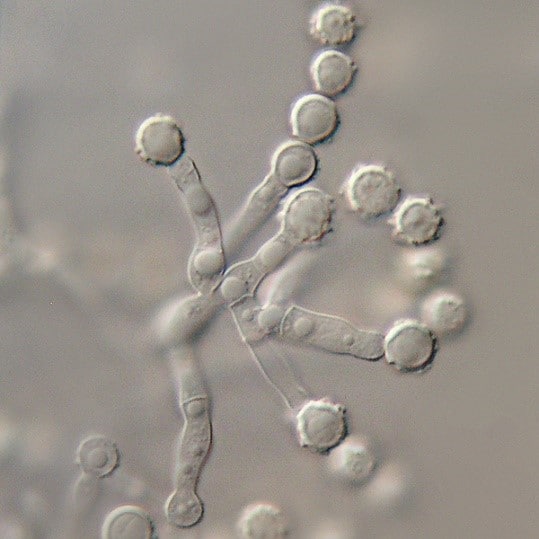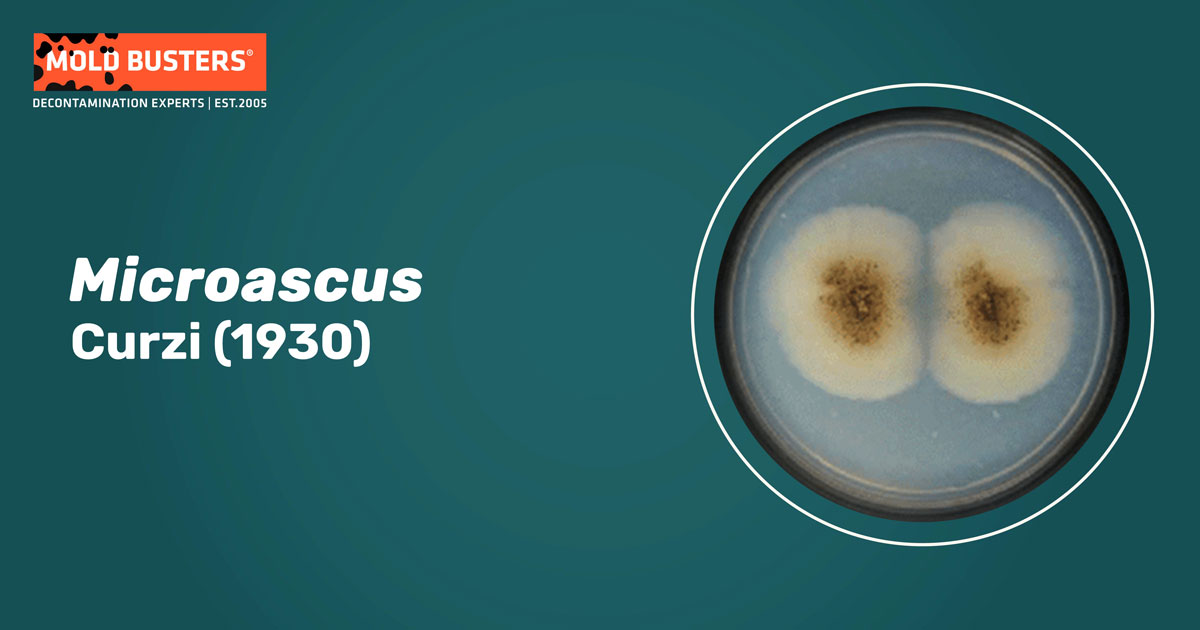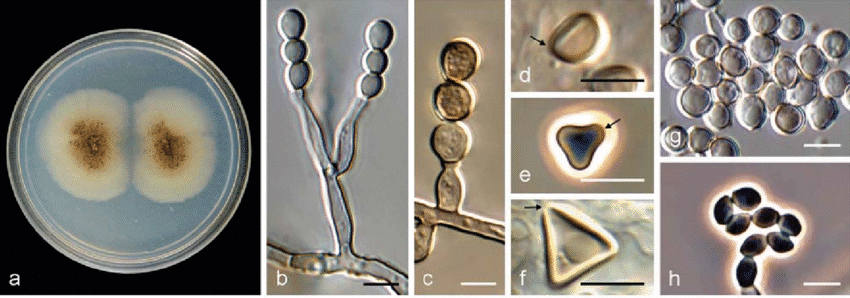Curzi (1930)
What is Microascus?
Microascus is a genus of filamentous fungi belonging to the family Microascaeae and the phylum Ascomycota. It comprises the sexual stages of species, whose asexual stages are included in the genus Scopulariopsis (Fig. 1) [1].


Microascus species are distributed worldwide and can be found in soil, plant material, dung, feathers, paper, grains, animal products, and damp indoor environments [1, 2, 3]. These species are saprophytic, obtaining nutrients directly from dead organic matter. Some species have been reported as opportunistic pathogens, causing superficial tissue infections in immunocompromised people [2]. There are also reports of certain Microascus species linked to deep tissue infections such as pneumonia, sinusitis, brain and heart infections [2].
What are cultural and microscopic features of Microascus?
Microascus produces white to gray or brownish colonies (Fig. 1 – a). Colonies are often restricted in growth, with a clear, amber exudate [1].
Mycelium is pigmented, consisting of septate hyphae [1, 2]. The fruiting bodies (perithecia) develop in concentric rings, appearing as small black dots. They are superficial or partly immersed, smooth, and with a well-differentiated opening (ostiolum). Asci (spore-containing sac-like structures) are oval and short-lived. Each ascus contains eight ascospores. Ascospores are non-septate, smooth-walled, asymmetrical. They may be kidney-shaped, heart-shaped, or triangular, depending upon the species (Fig. 2 –d, e, f). Ascospores are liberated through the ostiole in groups called cirrhi [1, 2].

Colony on Plate Count Agar (a), conidiogenous cells (b-c), ascospores (d-f), conidia (g-h)
Image source: Sandoval-Denis et al. (2016)
How many Microascus species exist?
The genus Microascus contains approximately fifteen species and is unique for including both moniliaceous (glass-like) and dematiaceous (pigmented) members [1]. The shape and size of the perithecia, as well as the shape of the ascospores, are used to differentiate between species. Many species produce the Scopulariopsis asexual stage [1]. Clinically significant species are M. cinereus, M. cirrosus, M. trigonosporus, and M. manginii.
What are Microascus adverse health effects?
Microascus cinereus has been linked to different human infections, such as nail infections, sinusitis, purulent skin infections (granulomata), endocarditis, and brain abscesses. Infections have been mostly reported in immunocompromised patients, such as after bone marrow transplants or heart valve transplants [1]. M. cirrosus has been reported as an agent of nail infection and disseminated infection in a child with a transplanted bone marrow transplant [1]. The asexual stage of Microascus trigonosporus has been linked to fatal pneumonia, whereas the asexual stage of Microascus manginii (Scopulariopsis candida) has been reported as an agent in an invasive infection of the nasal cavity and sinuses in a child with lymphoma [1].
How to treat Microascus spp.?
Antifungal susceptibility data for Microascus species is very scarce. Isolates tested were generally resistant to currently available antifungals, particularly to the azoles and 5-fluorocytosine. The antifungal response of Microascus species was similar to that of Scopulariopsis species (their asexual stage) [1]. The successful therapy of disseminated infection due to Microascus cirrosus consisted of high doses of amphotericin B and long-term itraconazole application [1].
What are safe levels of Microascus spores?
There is no information available referring to safe levels of Microascus spores in particular. During their spore count, they are mostly referred to as ascospores [3, 4].
According to reports, there are no current official standards or regulations regarding permissible levels of airborne fungi that may be present indoors [3, 4].
However, there are some recommendations and guidelines regarding general fungal spore counts. One of them is the publication issued by the American Conference of Governmental Industrial Hygienists [4], considering 100 spores or less per cubic meter of air indicates low risk, 100–1000 spores per cubic meter of air indicates intermediate risk, while 1000 or more spores per cubic meter of air indicate high risk. Acceptable levels for particular mold species vary based upon their toxicity and allergenic potential [3, 4]. As reported by Codina et al. 2008 [6], the average count of ascospores in indoor samples of Florida moisture-free houses is 53 spores per cubic meter, while in outdoor samples it is 688 spores per cubic meter.

Did you know?
Only 12% of tested indoor air quality samples in Canada didn’t have any presence of mold! Find out more exciting mold stats and facts on our mold statistics page.
References
- Microascus Retreated from: www.drfungus.com
- Sandoval-Denis, M. et. al. (2013). Redefining Microascus, Scopulariopsis and allied genera. Persoonia. 51(12): 3937–3943.
- Sutton, B. C. (2014). Encyclopedia of Food Microbiology: Second Edition. Amsterdam : Academic Press, Elsevier, Ltd. Chapter: Fungi. pp. 6.
- Eurofins (2013). MOLD SPORE TRAP REPORT Nonviable Direct Microscopy. Retreated from: www.eurofins.com
- Enzcycle lab, LLC. (2013). Interpretation of Air Test Results. Retreated from: www.consumermoldguide.org
- Codina, R. et al. (2008). Typical Levels of Airborne Fungal Spores in Houses Without Obvious Moisture Problems During a Rainy Season in Florida, USA The Journal of Investigational Allergology and Clinical Immunology. 18(3): 156-162.

Get Special Gift: Industry-Standard Mold Removal Guidelines
Download the industry-standard guidelines that Mold Busters use in their own mold removal services, including news, tips and special offers:

Written by:
Jelena Somborski
Mycologist
Mold Busters
Edited by:
Dusan Sadikovic
Mycologist – MSc, PhD
Mold Busters
